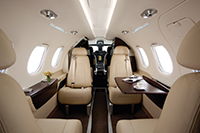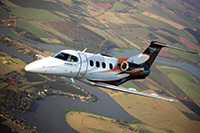
Features
Operations
Building on its Legacy
Alberto Santos-Dumont, Brazil’s most famous aviation pioneer, was always easy to spot in a crowd because of his trademark Panama hat. Although he died 37 years before the Brazilian government created Embraer in 1969, tributes to Santos-Dumont can be found all around the airframer’s sprawling complex in São José dos Campos, including an enlarged image of his famous hat.
November 3, 2011 By David Carr

|
|
| The Phenom 300 is more than just a stretch version of the 100; most notable is the low-swept back wing design of the 300.
|
Alberto Santos-Dumont, Brazil’s most famous aviation pioneer, was always easy to spot in a crowd because of his trademark Panama hat. Although he died 37 years before the Brazilian government created Embraer in 1969, tributes to Santos-Dumont can be found all around the airframer’s sprawling complex in São José dos Campos, including an enlarged image of his famous hat.
In the mid-1990s, deep in debt and facing a dwindling order book for its military aircraft and commercial turboprops, Embraer hung its own hat on the development of the ERJ 145, a 50-seat regional jet the company had put on hold at the height of its financial crisis. The ERJ 145 and its derivatives helped Embraer to privatize in 1994, set the stage for it to slide past Bombardier as the world’s largest builder of regional jets and paved the company’s entry into the business aviation market with the Legacy (since rebranded the Legacy 600), a super mid-size executive jet based on the same platform as the ERJ 135 derivative.
In the high-stakes game of developing and selling executive jets, timing is everything. Had the ERJ 145 development not been stalled, Embraer’s entry into the corporate market might have happened sooner, although the results may not have been the same. “The Legacy hit the market at just the right time,” explained Augusto Salgado da Rocha, senior manager of product strategy for the Executive Jets division. “The market was hot and rival manufacturers were pushing delivery times for new jets well into the future.”

|
|
| The surprisingly affordable Phenom 100 sports a high-end interior cabin that rivals much more expensive business jets.
|
Embraer has also been tapping into a new generation of wealthy customer less interested in the “go with who you know” culture that has benefited established manufacturers than in a bigger bang for the buck. Embraer accounted for 19 per cent of all deliveries in 2010 compared with 2.7 per cent in 2005.
The Executive Jet division has built an impressive portfolio in a short period of time. Its impressiveness was on display in Las Vegas during NBAA 2011. The company arrived with its entry-level and light Phenom 100 and 300, the Legacy 650, an updated, larger and more powerful successor to the 600, the Lineage 1000, an ultra-large version of the E-190 passenger jet and the latest mockup of the Legacy 500, the only full fly-by-wire aircraft in the mid-size market. The Legacy 500 is expected to make its first flight in late 2011.
Indeed, the only hole in Embraer’s executive jet line is in the ultra-long-range category. That gap will not be plugged anytime soon, according to Ernest Edwards, president of Embraer Executive Jets. “My team would love to fill the hole that is there, but engineering are saying, ‘Guys, give us a break.’ The engineers are just about maxed out,” he said. Instead, Embraer is hoping to use the 19-passenger Legacy 1000’s US$50.5-million price tag to lure ultra-long-range customers willing to give up range for added comfort.

|
|
| The aircraft Embraer sees as having the strongest potential for the Canadian market are the Phenom 100 and 300.
|
To date, the entry-level, four-passenger Phenom 100 is the only aircraft in the portfolio to have sold in Canada. Neither Legacy aircraft is certified to operate here. “The Canadian market is divided into two parts,” explained Edwards. “There is Calgary and there is Toronto east to Montreal. It would cost a couple of million to get the aircraft Transport Canada certified. You have to look at how many aircraft you can optimize that over, or whether the customer is prepared to pay a premium toward getting the aircraft certified.”
That will not be the case with the Legacy 500 or smaller 450, another full fly-by-wire design aimed at the mid-light market. Both airplanes are being designed for certification in all countries. But the aircraft Embraer sees as having the strongest potential for the Canadian market will be the Phenom 100 and 300. “We have great hopes for the Phenom in Canada,” Edwards added. Both aircraft were on display at the CBAA show in Calgary this year, along with the Canadian premiere of the Legacy 500 mockup.
Embraer launched the Phenom program in 2005. Deliveries of the 100 began in December 2008, followed 12-months later by the first deliveries of the 300. In 2010, the Phenom 100 was the most delivered executive jet in the world, whereas the 300 was the most delivered in its class. Deliveries slowed in the first half of 2011, although Edwards is confident that the program is on track to deliver 74 Phenoms in the second half, including the first Phenom to roll off Embraer’s new assembly plant at the Melbourne International Airport in Florida, the new headquarters for Embraer Executive Jets. (Twenty-two of Embraer’s 52 service centres worldwide are located in North America, including Starlink Aviation in Montreal).
The assembly plant is part of a US$50-million complex that includes a paint shop and customer design centre to support all executive jets in the Embraer portfolio. The facility has the capacity to build up to eight Phenoms a month and is expected to turn out 60 aircraft a year by 2013.
Despite the name, a similar design lineage, a shared cross-fuselage section and best-in-class customer features such as the cabin and baggage area (including a forward external baggage compartment on the 300), the Phenom 100 and larger 300 are two different aircraft, pointed out Carlos Fernandes, an Embraer executive jet product strategist. “The 300 is more than just a stretch version of the 100.” Most notable is the low swept back wing design of the 300 versus the super critical wing design of the 100.

|
|
| In 2010, the Phenom 100 was the most delivered executive jet in the world.
|
Powered by two Pratt & Whitney Canada PW535E engines, the 300 is twice as heavy as the 100, flies higher and faster, and has a range of 3,650 kilometres with a standard six-passenger occupancy. Both cockpits feature Embraer’s Prodigy avionics suite tailored from the Garmin G1000 and sometimes referred to by the manufacturer as a G1000 on steroids.
For the cabin interior, Embraer partnered with BMW Group Designworks on a mix-and-match concept that allows the customer to design their own interior from a wide selection of materials. Cabin highlights include the largest windows in its class, a large galley opposite the entrance and private lavatory. The cabin can be configured for up to nine passengers with an optional belted toilet.
At US$8.5-million per aircraft, the Phenom 300 has become a favourite in the fractional market. In 2010, NetJets the world’s largest fractional aircraft operator, placed an order for 50 300s with options for 75 more. The NetJet purchase followed a 2007 order by Flight Options, the second largest fractional company in the United States, for 100 Phenoms with an option for an additional 50.
Flight Options expects to have 16 300s in its fleet by year’s end. Earlier this year, Michael J. Silvestro, chief executive officer for the Cleveland-based operator, told London’s Financial Times that the airplane is Flight Options’ fastest-growing fractional program. “Our customers and prospects realize what a true game-changer this aircraft is. Every aircraft delivered to us has been pre-sold into 2011.”
Embraer predicts that the market for business jets troughed out in 2011, and the industry will rebound beginning in 2012, delivering 11,275 aircraft over the next 10 years worth approximately US$260 billion. The light category, occupied by the Phenom 300, will be the busiest market segment, capturing 18 per cent of all orders. The United States will continue to be the largest single market, and along with Canada, will account for approximately 5,265 aircraft, or 47 per cent, of all orders. Edwards sees strong growth potential in Brazil and Mexico, which has an aging fleet of executive aircraft that will need replacing, and China, whose market he compares with his time in the Middle East in the 1970s. “In the mid-’70s they started at the upper end of the market and then they moved into other segments. You are seeing the same thing happen with China starting with the ultra-high range.”
In 2005, Embraer unveiled a 10-year business strategy to parallel its success in the regional jet market by becoming one of the world’s biggest manufacturers of executive jets. Despite a number of bright spots, the market downturn resulted in the airframer not reaching where it forecast to be in deliveries when the strategy was launched. The four years were not wasted, however, and Embraer was one of the most aggressive in new product launches, enabling the company to boost its portfolio and better align itself to ride the recovery.